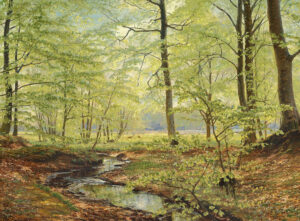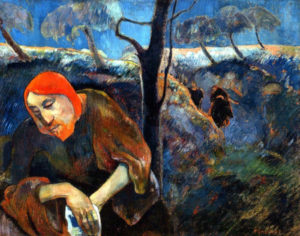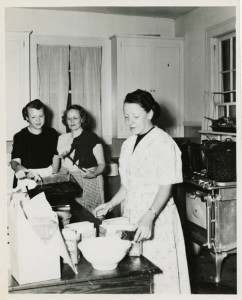And here now is your belated Convivio Book of Days calendar for April. Cover star: “Beech Trees in Springtime,” an 1897 oil painting by Christian Zacho. It is filled with the ephemeral spring green of newly leafed trees, which, if you are lucky, you will be seeing a fair amount of in the coming weeks, as spring comes into its own. An annual bit of wonder and renewal. We see it even here, in this strange green land, in an albeit subtle way: passing by a stand of bald cypress, for instance, as we drive across the state on Alligator Alley. It is a fine time to take a drive or to take a walk and see something new and fresh and green.
We find ourselves, too, in the midst of an important week, across cultures and spiritual traditions: Ramadan continues and at sundown tonight, Passover begins. And it is Holy Week, a week of complexity and mystery in which the forty days of Lent, which we’ve been immersed in since Ash Wednesday, will come to a close. It began last Sunday with Palm Sunday. Thursday will bring Holy Thursday, or Maundy Thursday, when tradition would have us visit three churches in the moonlit night, Friday will bring Good Friday, when we commemorate the passion of Christ, and Saturday the vigil through which we wend our way toward Easter.
What I know about Ramadan is not much and what I know about Passover is perhaps just a bit more, and is mostly is in relation to my Catholic upbringing and to Passover’s connexion to the Easter story. I know that Passover commemorates the liberation of the Israelites from their slavery in Egypt, and I know what a friend told me once, which has always resonated with me about the holiday: “We are traveling through the desert with our ancestors via a table filled with metaphor and symbolism.” The meal is the seder, the same meal that Jesus celebrated with his disciples in the upper room on that Holy Thursday night before he died. Pesach is the Hebrew name for Passover, and Pesach informs the name for Easter in many languages. Hence our Italian word for the day and season: Pasqua. And while Ramadan roams the calendar, falling a few weeks earlier each year, Pesach, Pasqua, and a full- or near-full Paschal moon are all constant companions based on the timing of the spring equinox.
The Last Supper is the Passover meal in the upper room that is commemorated at the Mass for Holy Thursday. Each year, as Lent begins, I think to myself, “This is the year I’m going to do things right.” I imagine myself taking the time to give the forty days their proper space and time, to be more mindful, and give them more reverence. And each year those forty day zip by and I find myself here, at this junction where Lent runs headlong into Holy Week, and I realize I just have these few days left to make things right. Holy Thursday is my night to do this. I drag Seth along with me, if he has it in him, on a Holy Thursday pilgrimage that my grandmother taught me: as the rest of the world is contemplating sleep, we will head out into the night and visit three churches. The churches that know Grandma’s ways will keep their doors open late into the night, or even throughout the night until morning. The moon is our companion through this pilgrimage, along with a few other hearty souls who visit the churches with us. The churches will be dim but warm with candle glow and quiet and the presence, to me at least, of all the loved ones I bring with me in my heart. I sit, I kneel, I pray, I ponder. It is a night like no other, the strongest bridge I know between realms. We each, of course, bring to it what we bring, but this is what my Holy Thursdays, my Maundy Thursdays, are like, and I feel truly at home in the mystery.
•
IT MAY BE NOT TOO LATE to order things from our website for Easter. We ship US Priority Mail, which is two days to most domestic destinations, so chances are good you’ll have your order by Saturday. Locals, of course, we can deliver to you or you can come pick up at our front porch. It’s a little too warm these days to ship our German chocolates for Easter, but locals: I don’t know that there’s anywhere else nearby where you’ll find German milk chocolate bunnies and German marzipan bunnies. We have a few left of each. Plus Ukrainian pysanky, wooden bunnies and splint wood baskets and paper mache eggs from Germany, handmade egg-shaped candles from Sweden…. many Easter delights await you at Convivio Bookworks! CLICK HERE to shop. And use discount code BUNNY at checkout to get $10 off your purchase of $85 on all our offerings, plus free domestic shipping!
AND WON’T YOU JOIN ME this Friday, Good Friday, via Zoom for Real Mail Fridays? It’s a weekly online social I host for the Jaffe Center for Book Arts. Good Friday is an odd day for a social, I know, so the approach I’m planning is this: a more subdued soundtrack for the first two hours, and then we’ll devote the final hour of our gathering to a most sublime recording called “Lamentations: Holy Week in Provence.” It’s by the Boston Camerata. “Lamentations” is a most beautiful piece of music, and we will play it uninterrupted from 4:00 Eastern to the close of our online social. We do bill Real Mail Fridays as a letter writing social, but the folks who join us each week from around the globe do all kinds of interesting things during our time together. We’ll begin as we always do, at 2:00 Eastern. Come and go as you please but do consider joining us for “Lamentations” beginning at 4. No matter your faith tradition or your beliefs, it is a most special way to mark the day. CLICK HERE to join us Friday between 2 and 5 Eastern.
Image: “Beech Trees in Springtime” by Christian Zacho. Oil on canvas, 1897. [Public domain] via Wikimedia Commons.


